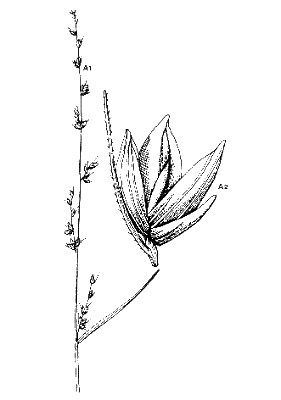 |
 |
|
 |
 |
|

Paspalidium grandispiculatum B.K.Simon
|
Derivation
Paspalidium Stapf in D.Prain, Fl. Trop. Afr. 9: 15, 582 (1920); from Paspalum (another grass genus) and the Greek -idium, a diminutive but here employed as a name-forming suffix.
grandispiculatum- from the Latin grandis (large), spiculus (small spike) and -atum (possessing). Spikelets large.
Published in
Austrobaileya 1: 465 (1982).
Common synonyms
Setaria grandispiculata (B.K.Simon) R.D.Webster
Habit
Perennial, tufted. Cataphylls present. Rhizomes elongated, woody. Culms erect,
40–150 cm tall, woody, 4–9-noded. Mid-culm internodes hollow, glaucous,
pruinose or glabrous. Lateral branches sparsely branched. Leaf-sheaths glabrous
on surface. Leaf-sheaths outer margin glabrous. Ligule a fringed membrane or
a fringe of hairs, 1 mm long. Leaf-blades flat or conduplicate, 3.5–9 cm
long, 2–5 mm wide. Leaf-blade surface scaberulous or scabrous. Leaf-blade
margins scabrous.
Inflorescence
Inflorescence compound, a panicle of racemes. Racemes 5–8, appressed, unilateral,
0.5–4.5 cm long, 0.3–0.4 mm wide, bearing few fertile spikelets, bearing
3–8 fertile spikelets on each. Central inflorescence axis 8–22 cm
long, puberulous. Rhachis angular, terminating in a barren subulate or bristle-like
extension 2–4 mm long. Spikelet packing abaxial.
Spikelets
Spikelets subtended by an involucre. Involucre composed of persistent bristles,
1 in principal whorl, 1 per spikelet, 3–4 mm long. Pedicels oblong, 0.5–1
mm long, puberulous. Fertile spikelets 2-flowered, comprising 1 fertile floret,
lower floret male, upper fertile, without rhachilla extension, ovate, dorsally
compressed, 3.5–4.8 mm long, falling entire.
Glumes
Glumes thinner than fertile lemma. Lower glume ovate, clasping, not gibbous,
2.3–3 mm long, 50% of length of spikelet, scarious, 5–7-nerved.
Lower glume surface asperulous, glabrous. Lower glume apex obtuse, muticous.
Upper glume elliptic, 3.3–3.9 mm long, 75% of length of spikelet, membranous,
7–9-nerved, midnerve scaberulous. Upper glume apex obtuse or acute.
Florets
Basal sterile floret 1, with palea. Lemma of lower sterile floret similar to
upper glume, elliptic, 4.1–4.8 mm long, 100% of length of spikelet,
membranous, 5-nerved, scaberulous, obtuse. Fertile lemma elliptic, 3–4.6
mm long, indurate, of similar consistency on margins, 5–7-nerved. Lemma
surface rugulose or rugose. Lemma margins involute. Lemma apex acute, mucronate.
Palea reflexed at apex, indurate, 2-keeled. Anthers 3, 2.5 mm long. Grain with
adherent pericarp, 3 mm long. Embryo 20% of length of grain.
Continental Distribution:
Australasia.
Australian Distribution:
Queensland: Burnett, Moreton.
Classification. (GPWG
2001):
Panicoideae: Paniceae
Notes
Native. In tropical and subtropical rain forests and tropical and subtropical
sub-humid woodlands. Flowers Feb.–Nov.

Spikelet (line drawing)
© Stanley and Ross 1989